
 Department Homepage
Department Homepage
Fun, hands-on course teaches science communication
The course goal is to produce one or two polished exhibit ideas for Ithaca's Sciencenter.




